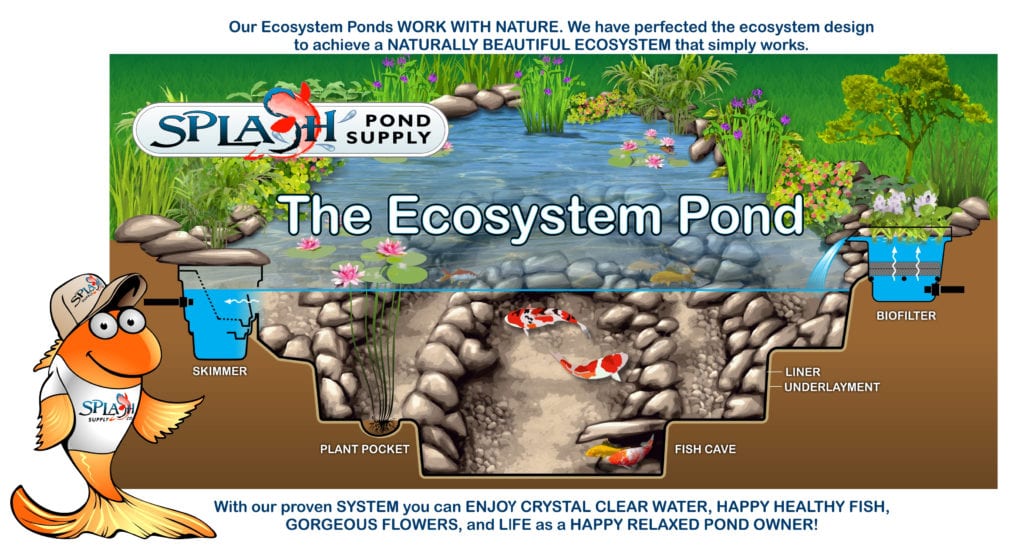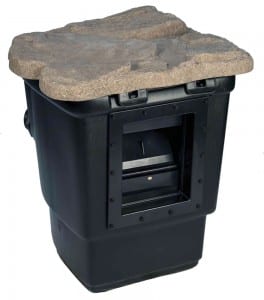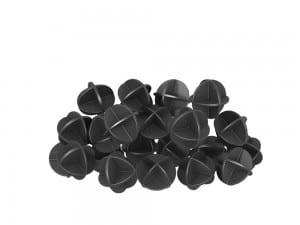
We didn’t invent the ecosystem that keeps our fish happy and our water crystal clear. Nature did. What we try to do is replicate nature in a man-made environment.
So digging a hole in the ground, throwing in the garden hose and calling it a day isn’t going to cut it.
Each element of a properly designed pond has a crucial role to play in keeping your ecosystem balanced and your pond a pleasant place to hang out. Fish eat mosquitos, bacteria eat gases that fish waste creates and plants eat the waste that the bacteria produce. When this process gets out of whack, pond owners start to run into issues like string algae and green water.
Below, we’ll dive into some details about all of these elements and more. The science sounds complicated, but the end result is a low-maintenance pond ecosystem that all but takes care of itself.
The Biology
Koi, Goldfish, etc.
If you’re thinking about building a pond without fish, here’s some advice: don’t. Or at least think very carefully about why you don’t want them. Your fish will eat many of the mosquitos and other biting insects that might otherwise congregate around the lovely pool of water you’ve built them. Fish like koi and goldfish will also be the easiest-to-care-for pets you’ve ever owned.
Check Out Our Ultimate Guide to Pond Fish Care
What about fish poop? Glad you asked. Fish waste, along with leaves and other debris that sink to the bottom of your pond, break down and produce ammonia. Ammonia build-up will kill your fish if left alone. Luckily, nature has a solution …
Bacteria
Bacteria and enzymes are tiny, but they control so, so much of your pond’s ecosystem.
One of the most important roles they play is to break down ammonia and convert it into nitrites.
Nitrites – and More Bacteria
Your fish can generally live with a reasonable level of nitrites in the water. But there’s somebody else in your pond that absolutely love nitrites: single-cell algae.
Single-cell algae will make your lovely, crystal-clear pond green and mucky. The best way to regain control is usually not by dumping in algaecides – although those do sometimes have a role to play – but rather by starving the algae.
That’s where more bacteria comes into play. Different types will eat the nitrites – thus taking away the single-cell algae’s food source – and convert them into nitrates.
You might see now just how important these microscopic bacteria are to your pond’s ecosystem. You can help colonies grow by installing a biofilter, as well as making sure they have lots of gravel in which to settle and thrive (read more about these things below).
Nitrates and Pond Plants
Nitrates brings with them their own unwelcome guest to your pond: string algae.
String algae thrives on nitrates in much the same way single-cell algae thrives on nitrites. Like always, though, Mother Nature has a solution: your pond plants.
Different types of plants will eat different kinds of nitrates. An iris will suck up one kind, and a lily will consume another. A blue flower will chow down on one, and a pink flower yet another. A plant that blooms in May will eat a different kind than one that blooms in September.
A large variety of plants will provide your best protection against string algae.
The Design
These processes take place naturally in many ponds. As humans trying to recreate nature, we have to find ways to help the cycle along by constructing the best environment possible for our little ecosystems.
Plant Shelves
A good ecosystem pond will include plant shelves at various depths in the pond. A medium-sized pond might, for example, have shelves or steps at 8, 16 and 24 inches deep.
These shelves serve a few purposes. First, they give your family, your pets and you an easy and safe way to enter and exit your pond. A terraced design with steps is a lot easier to escape that a bowl with steep, slippery sides.
These shelves also make your plants happy. Remember how we said a wide variety of plants is good for sucking up a wide variety of nitrates? Different plants thrive at different water depths, so shelves of varying depths ensure you can fit in even more kinds of plants.
Fish Caves
If you’ve heard the expression “like shooting fish in a barrel,” you probably understand why your fishy friends need places to hide.
Fish caves are built-in underwater structures where your koi, goldfish, catfish, etc. can quickly dive to get away from approaching heron and other predators. Anyone who has ever come out to their pond to discover that a koi fish they’ve owned for 15 years is suddenly gone knows just how important this kind of safeguard is.
Products like motion-sensitive sprinklers (Scarecrows), fake alligators, decoy heron and nets can also help ward off the hungry critters.
Physical Filter

A properly designed pond will include a physical skimming-type filter capable of removing 80 to 90 percent of the debris that enters your pond. The skimmer pulls leaves, twigs, pollen and fish waste into a basket you can easily empty without diving to the bottom of the pond to muck out debris and unclog your pump.
If you’re unlucky enough to own a pond without a skimmer, you have to do the dirty work yourself. That means scooping out the pond yourself on a regular basis – something that’s a lot harder to do than dumping out a skimmer basket once a week.
Your pump, the heart of your pond’s circulatory system, is housed out-of-sight in the skimmer.
Rocks and Gravel
Those beneficial bacteria that keep algae at bay love one thing beyond all else: surface area. And all the nooks in crannies in gravel give them lots of area in which to eat and thrive.
In an ecosystem pond, beneficial bacteria colonize on the surface of the pond rock and gravel and break down the waste remaining after the skimmer has done its work. Working together, the skimmer and gravel help keep required maintenance to a minimum. This style of pond is a big improvement over older-style ones that do not have skimmers or gravel. Gravel also has the added benefit of looking nice and adding some traction to the top of your slippery pond liner.
Biofiltration

Biofiltration is the word we use to describe the natural process that keeps your water crystal clear and your fish happy and healthy. A biofilter helps this process along.
Water flows up through your biofilter and then back into your pond over the rocks. Beneficial bacteria – the ones that convert ammonia to nitrites and then nitrates – colonize inside your filter in much the same way they do on your rocks. They can do this thanks to all the nooks and crannies built into the filter, usually in the form of BioBalls or lava rock.